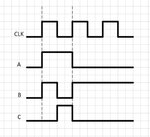spade7
Newbie level 5
Hello,
I am rather new on VHDL. I have done some code in the past but I have a problem concerning how to manipulate B and C signals (as shown below). Actually, it is a state machine and I am trying to change the logic of these signals (B & C) in half of the clock pulse. Could you please give me some hints how to do it? Thank you

I am rather new on VHDL. I have done some code in the past but I have a problem concerning how to manipulate B and C signals (as shown below). Actually, it is a state machine and I am trying to change the logic of these signals (B & C) in half of the clock pulse. Could you please give me some hints how to do it? Thank you

